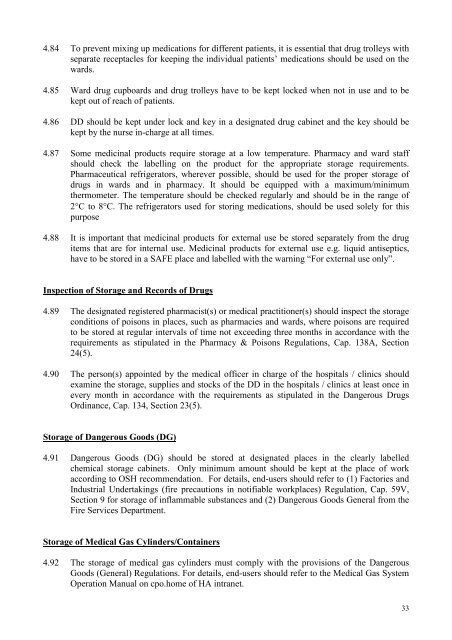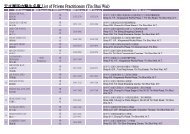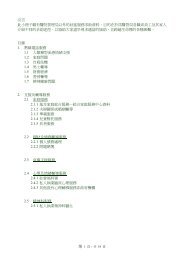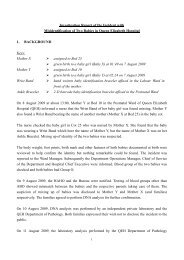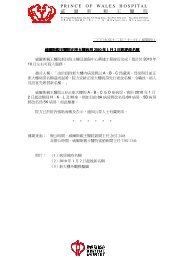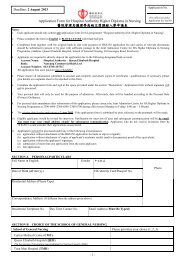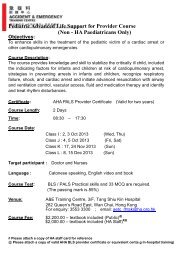2005 Edition Report on Drug Administration Procedure & Practices ...
2005 Edition Report on Drug Administration Procedure & Practices ...
2005 Edition Report on Drug Administration Procedure & Practices ...
Create successful ePaper yourself
Turn your PDF publications into a flip-book with our unique Google optimized e-Paper software.
4.84 To prevent mixing up medicati<strong>on</strong>s for different patients, it is essential that drug trolleys withseparate receptacles for keeping the individual patients’ medicati<strong>on</strong>s should be used <strong>on</strong> thewards.4.85 Ward drug cupboards and drug trolleys have to be kept locked when not in use and to bekept out of reach of patients.4.86 DD should be kept under lock and key in a designated drug cabinet and the key should bekept by the nurse in-charge at all times.4.87 Some medicinal products require storage at a low temperature. Pharmacy and ward staffshould check the labelling <strong>on</strong> the product for the appropriate storage requirements.Pharmaceutical refrigerators, wherever possible, should be used for the proper storage ofdrugs in wards and in pharmacy. It should be equipped with a maximum/minimumthermometer. The temperature should be checked regularly and should be in the range of2°C to 8°C. The refrigerators used for storing medicati<strong>on</strong>s, should be used solely for thispurpose4.88 It is important that medicinal products for external use be stored separately from the drugitems that are for internal use. Medicinal products for external use e.g. liquid antiseptics,have to be stored in a SAFE place and labelled with the warning “For external use <strong>on</strong>ly”.Inspecti<strong>on</strong> of Storage and Records of <strong>Drug</strong>s4.89 The designated registered pharmacist(s) or medical practiti<strong>on</strong>er(s) should inspect the storagec<strong>on</strong>diti<strong>on</strong>s of pois<strong>on</strong>s in places, such as pharmacies and wards, where pois<strong>on</strong>s are requiredto be stored at regular intervals of time not exceeding three m<strong>on</strong>ths in accordance with therequirements as stipulated in the Pharmacy & Pois<strong>on</strong>s Regulati<strong>on</strong>s, Cap. 138A, Secti<strong>on</strong>24(5).4.90 The pers<strong>on</strong>(s) appointed by the medical officer in charge of the hospitals / clinics shouldexamine the storage, supplies and stocks of the DD in the hospitals / clinics at least <strong>on</strong>ce inevery m<strong>on</strong>th in accordance with the requirements as stipulated in the Dangerous <strong>Drug</strong>sOrdinance, Cap. 134, Secti<strong>on</strong> 23(5).Storage of Dangerous Goods (DG)4.91 Dangerous Goods (DG) should be stored at designated places in the clearly labelledchemical storage cabinets. Only minimum amount should be kept at the place of workaccording to OSH recommendati<strong>on</strong>. For details, end-users should refer to (1) Factories andIndustrial Undertakings (fire precauti<strong>on</strong>s in notifiable workplaces) Regulati<strong>on</strong>, Cap. 59V,Secti<strong>on</strong> 9 for storage of inflammable substances and (2) Dangerous Goods General from theFire Services Department.Storage of Medical Gas Cylinders/C<strong>on</strong>tainers4.92 The storage of medical gas cylinders must comply with the provisi<strong>on</strong>s of the DangerousGoods (General) Regulati<strong>on</strong>s. For details, end-users should refer to the Medical Gas SystemOperati<strong>on</strong> Manual <strong>on</strong> cpo.home of HA intranet.33


